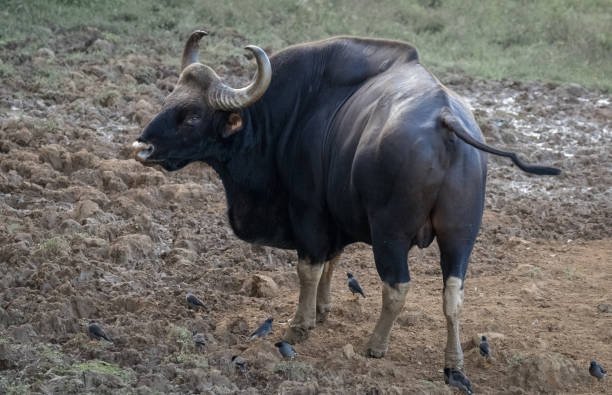
To put it simply, the gaur can be dangerous, but not in the way you might think. They’re not out to get you, but as with any wild animal, things can change if they feel threatened. Imagine a cornered dog; it may not want to bite you, but if it feels scared or trapped, it might lash out. That’s a bit like the gaur.
In this article, we’ll delve into the world of these fascinating animals, exploring their behavior, habitat, and the conditions under which they might pose a danger to people. So, grab a cup of coffee, and let’s chat about the gaur and what you should know!
Understanding the Gaur: An Overview
The gaur, or Bos gaurus, is a remarkable animal. Native to South and Southeast Asia, they live in forests and grasslands. Think of them as the gentle giants of the jungle—despite their size and power, they prefer to live peacefully. Adult gaurs can weigh between 1,000 to 2,200 pounds, with some standing up to six feet tall at the shoulder! That’s about the same height as a basketball hoop!
Their fur is usually a dark brown to black, with white markings on their legs and a distinct hump on their back. This hump is not just for show; it supports their immense muscles. Seeing one in the wild is like witnessing a living piece of nature’s artwork—both beautiful and a bit intimidating.
You might wonder how they fit into their ecosystem. The gaur plays a critical role as a herbivore, helping to shape the forest landscape by grazing on grasses and shrubs. They contribute to the health of their environment while maintaining a delicate balance among various species.
Are Gaurs Naturally Aggressive?
Let’s address the elephant in the room—are gaurs aggressive? The short answer is no, but let me explain. Gaurs are generally peaceful creatures, more inclined to graze peacefully than to charge at anything that moves. But, here’s the thing: like many animals, they have a fight-or-flight response.
When provoked, a gaur can become aggressive. This might happen if they feel their young are threatened or if a human gets too close. A surprised or cornered gaur may choose to defend itself. Think of it like this: most people don’t want trouble, but if someone corners you, you might react defensively.
In areas where they coexist with humans, reports of attacks are rare. Still, it’s essential to respect their space. Maintaining a safe distance is key. If you see one in the wild, admire it from afar, and you’re less likely to find out how dangerous a gaur can be.
Conditions That Lead to Dangerous Encounters
While gaurs aren’t out for blood, certain situations can trigger dangerous encounters. It’s crucial to be aware of these to ensure safety. Here are a few conditions that can lead to an aggressive response:
- Mother with Calves: If a mother gaur feels her calves are threatened, she’ll do anything to protect them. This is a prime example of a natural instinct kicking in, so always steer clear of young ones.
- Getting Too Close: Approaching a gaur too closely—especially if it feels cornered—can provoke an attack. Remember, they’re wild animals, not pets!
- Sudden Movements: Quick, unexpected movements can startle a gau and lead it to react defensively. It’s like when a startled deer bolts; the response is instinctual.
By understanding these triggers, you can help minimize risks. The key is to observe from a distance and respect their natural behavior.
How to Safely Observe Gaurs in the Wild
So, you’re excited to see a gaur in its natural habitat. How can you do this safely? Here are some tips:
1. Stay at a Distance: Always maintain a safe distance from these animals. A good rule of thumb is to stay at least 50 yards away. You’ll still get a great view without putting yourself in danger.
2. Use Binoculars: These handy tools can help you observe without getting too close. They allow you to enjoy the experience safely.
3. Take Guided Tours: Going with a knowledgeable guide can greatly enhance your experience. They understand animal behavior and know how to keep you safe.
4. Be Quiet and Calm: Avoid loud noises or sudden movements that could startle the gaur. Just breathe and take it all in!
By following these steps, you’ll be able to enjoy the beauty of gaurs without compromising your safety.
The Role of Gaurs in Their Ecosystem
While we may focus on their potential danger to humans, it’s essential to appreciate the role gaurs play in their ecosystem. These large herbivores help shape their environment in significant ways. Their grazing habits maintain the balance of plant life, allowing other species to thrive.
Gaurs also impact the structure of forests. By feeding on certain plants, they help control the growth of vegetation, which benefits other animals and the overall health of the ecosystem. Think of them as nature’s gardeners, trimming and shaping the landscape.
However, habitat loss and hunting pose risks to their populations. This means understanding and respecting the gaur is crucial for conservation efforts. Protecting these creatures ensures that they continue to play their vital role in nature.
In the grand scheme of wildlife, the gaur holds a fascinating and unique position. While they can be dangerous under specific circumstances, they are generally non-aggressive animals that prefer a quiet life in the forest. By understanding their behavior and respecting their space, we can safely enjoy the majesty of these magnificent creatures.
Next time you think of the gaur, remember: they’re not out to get you, but they are wild animals deserving of our respect and admiration. So, if you ever have the chance to see one, take a moment to appreciate both its beauty and its role in nature—keeping a safe distance, of course!
